High-Speed Rotary Ultrasonic Elliptical Milling of Ti-6Al-4V Using High-Pressure Coolant
Abstract
:1. Introduction
2. Principle of Tool-Workpiece Separation Cooling Effect in HRUEM
2.1. Kinematic Analysis of Tool Tip Trajectories in HRUEM
2.2. The Principle of Tool-Workpiece Separation in HRUEM
2.3. Analysis of High-Pressure Coolant in HRUEM
3. Material and Experimental Procedures
3.1. Workpiece Material
3.2. Machining Setup
3.3. Testing Method
4. Results and Discussion
4.1. Tool Life
- (1)
- Average flank wear VB = 0.2 mm,
- (2)
- Maximum flank wear VBmax = 0.3 mm,
- (3)
- Excessive chipping/flaking or catastrophic fracture of the cutting edge.
4.2. Material Removal Volume
4.3. The Average Integral Temperature over the Tool-Chip Interface
4.4. Tool Wear Mechanism
5. Conclusions
- (1)
- The tool life was significantly extended in both CM and HRUEM by using HPC and the effect of cooling enhanced as the coolant pressure escalated. However, the cooling effect in HRUEM was much greater than that in CM under same coolant condition. At the coolant pressure of 200 bar, the tool life in HUREM was 7.6 times of that in CM at 80 m/min, 5.2 times of that in CM at 120 m/min and 3.4 times of that in CM at 160 m/min.
- (2)
- At 200 bar HPC and 80 m/min cutting speed, the MRV of HRUEM increased by about 657% compared to that of CM. In contrast of the CM at a cutting speed of 80 m/min and 200 bar HPC, the MRV in HRUEM at the cutting speed of 160 m/min and 200 bar HPC went up by about 135% and the material removal rate (MRR) was also doubled in HRUEM. Therefore, HRUEM with HPC was an effective method for milling of titanium alloys with high efficiency.
- (3)
- When the cutting speed was 80 m/min with 200 bar HPC, the cutting temperature of the workpiece in HRUEM was reduced by 24.1% compared to that of CM. The significant temperature reduction in HRUEM was a result of much higher heat convection efficiency between the cutting edge and coolant by the intermittent cutting mode achieved in this method.
- (4)
- HPC could offer a cooling effect and lubrication effect for tools in CM, however, the coolant still failed to reach the cutting edge, resulting in tool wear modes of severe adhesion wear and oxidative wear in CM. When HPC was applied in HRUEM, the cooling and lubrication efficiency could be significantly enhanced with the combination of high-pressure coolant and tool-workpiece periodic separation. As a result, the tool wear mode of adhesive wear was able to significantly inhibit in HRUEM.
Author Contributions
Funding
Conflicts of Interest
References
- Ezugwu, E.O.; Wang, Z.M. Titanium alloys and their machinability a review. J. Mater. Process. Technol. 1997, 68, 262–274. [Google Scholar] [CrossRef]
- Moussaoui, K.; Mousseigne, M.; Senatore, J.; Chieragatti, R.; Lamesle, P. Influence of Milling on the Fatigue Lifetime of a Ti6Al4V Titanium Alloy. Metals 2015, 5, 1148–1162. [Google Scholar] [CrossRef]
- Thomas, M.; Turner, S.; Jackson, M. Microstructural damage during high-speed milling of titanium alloys. Scr. Mater. 2010, 62, 250–253. [Google Scholar] [CrossRef]
- Su, H.; Liu, P.; Fu, Y.; Xu, J. Tool Life and Surface Integrity in High-speed Milling of Titanium Alloy TA15 with PCD/PCBN Tools. Chin. J. Aeronaut. 2012, 25, 784–790. [Google Scholar] [CrossRef] [Green Version]
- Li, Y.; Zheng, G.; Zhang, X.; Cheng, X.; Yang, X.; Xu, R. Cutting force, tool wear and surface roughness in high-speed milling of high-strength steel with coated tools. J. Mech. Sci. Technol. 2019, 33, 5393–5398. [Google Scholar] [CrossRef]
- Mantle, A.L.; Aspinwall, D.K. Surface integrity of a high speed milled gamma titanium aluminide. J. Mater. Process. Technol. 2001, 118, 143–150. [Google Scholar] [CrossRef]
- Venugopal, K.A.; Paul, S.; Chattopadhyay, A.B. Growth of tool wear in turning of Ti-6Al-4V alloy under cryogenic cooling. Wear 2007, 262, 1071–1078. [Google Scholar] [CrossRef]
- Li, A.; Zhao, J.; Luo, H.; Pei, Z.; Wang, Z. Progressive tool failure in high-speed dry milling of Ti-6Al-4V alloy with coated carbide tools. Int. J. Adv. Manuf. Technol. 2011, 58, 465–478. [Google Scholar] [CrossRef]
- Sharma, V.S.; Dogra, M.; Suri, N.M. Cooling techniques for improved productivity in turning. Int. J. Mach. Tools Manuf. 2009, 49, 435–453. [Google Scholar] [CrossRef]
- Ke, Y.-L.; Dong, H.-Y.; Liu, G.; Zhang, M. Use of nitrogen gas in high-speed milling of Ti-6Al-4V. Trans. Nonferr. Met. Soc. China 2009, 19, 530–534. [Google Scholar] [CrossRef]
- Su, Y.; He, N.; Li, L.; Li, X.L. An experimental investigation of effects of cooling/lubrication conditions on tool wear in high-speed end milling of Ti-6Al-4V. Wear 2006, 261, 760–766. [Google Scholar] [CrossRef]
- Koklu, U.; Basmaci, G. Evaluation of Tool Path Strategy and Cooling Condition Effects on the Cutting Force and Surface Quality in Micromilling Operations. Metals 2017, 7, 426. [Google Scholar] [CrossRef] [Green Version]
- Lv, D.; Xu, J.; Ding, W.; Fu, Y.; Yang, C.; Su, H. Tool wear in milling Ti40 burn-resistant titanium alloy using pneumatic mist jet impinging cooling. J. Mater. Process. Technol. 2016, 229, 641–650. [Google Scholar] [CrossRef]
- Lu, Z.; Zhang, D.; Zhang, X.; Peng, Z. Effects of high-pressure coolant on cutting performance of high-speed ultrasonic vibration cutting titanium alloy. J. Mater. Process. Technol. 2020, 279, 116584. [Google Scholar] [CrossRef]
- Kovacevic, R.; Cherukuthota, C.; Mazurkiewicz, M. High pressure waterjet cooling/lubrication to improve machining efficiency in milling. Int. J. Mach. Tools Manuf. 1995, 35, 1459–1473. [Google Scholar] [CrossRef]
- Bermingham, M.J.; Palanisamy, S.; Morr, D.; Andrews, R.; Dargusch, M.S. Advantages of milling and drilling Ti-6Al-4V components with high-pressure coolant. Int. J. Adv. Manuf. Technol. 2014, 72, 77–88. [Google Scholar] [CrossRef]
- Diniz, A.E.; Micaroni, R. Influence of the direction and flow rate of the cutting fluid on tool life in turning process of AISI 1045 steel. Int. J. Mach. Tools Manuf. 2007, 47, 247–254. [Google Scholar] [CrossRef]
- Zheng, K.; Liao, W.; Dong, Q.; Sun, L. Friction and wear on titanium alloy surface machined by ultrasonic vibration-assisted milling. J. Braz. Soc. Mech. Sci. Eng. 2018, 40, 411. [Google Scholar] [CrossRef]
- Maurotto, A.; Wickramarachchi, C.T. Experimental investigations on effects of frequency in ultrasonically-assisted end-milling of AISI 316L: A feasibility study. Ultrasonics 2016, 65, 113–120. [Google Scholar] [CrossRef]
- Niu, Y.; Jiao, F.; Zhao, B.; Wang, D. Multiobjective optimization of processing parameters in longitudinal-torsion ultrasonic assisted milling of Ti-6Al-4V. Int. J. Adv. Manuf. Technol. 2017, 93, 4345–4356. [Google Scholar] [CrossRef]
- Ni, C.; Zhu, L.; Liu, C.; Yang, Z. Analytical modeling of tool-workpiece contact rate and experimental study in ultrasonic vibration-assisted milling of Ti–6Al–4V. Int. J. Mech. Sci. 2018, 142–143, 97–111. [Google Scholar] [CrossRef]
- Tsai, M.Y.; Chang, C.T.; Ho, J.K. The Machining of Hard Mold Steel by Ultrasonic Assisted End Milling. Appl. Sci. 2016, 6, 373. [Google Scholar] [CrossRef] [Green Version]
- Niu, Y.; Jiao, F.; Zhao, B.; Gao, G.F. Investigation of Cutting Force in Longitudinal-Torsional Ultrasonic-Assisted Milling of Ti-6Al-4V. Materials 2019, 12, 1955. [Google Scholar] [CrossRef] [PubMed] [Green Version]
- Lago, J.; Trsko, L.; Jambor, M.; Novy, F.; Bokuvka, O.; Mician, M.; Pastorek, F. Fatigue Life Improvement of the High Strength Steel Welded Joints by Ultrasonic Impact Peening. Metals 2019, 9, 619. [Google Scholar] [CrossRef] [Green Version]
- Brehl, D.E.; Dow, T.A. Review of vibration-assisted machining. Precis. Eng. 2008, 32, 153–172. [Google Scholar] [CrossRef]
- Liu, J.; Jiang, X.; Han, X.; Zhang, D. Influence of parameter matching on performance of high-speed rotary ultrasonic elliptical vibration-assisted machining for side milling of titanium alloys. Int. J. Adv. Manuf. Technol. 2018, 101, 1333–1348. [Google Scholar] [CrossRef]
- Geng, D.; Liu, Y.; Shao, Z.; Zhang, M.; Jiang, X.; Zhang, D. Delamination formation and suppression during rotary ultrasonic elliptical machining of CFRP. Compos. Part B Eng. 2020, 183, 107698. [Google Scholar] [CrossRef]
- Geng, D.; Liu, Y.; Shao, Z.; Lu, Z.; Cai, J.; Li, X.; Jiang, X.; Zhang, D. Delamination formation, evaluation and suppression during drilling of composite laminates: A review. Compos. Struct. 2019, 216, 168–186. [Google Scholar] [CrossRef]
- Liu, J.; Jiang, X.; Han, X.; Gao, Z.; Zhang, D. Effects of rotary ultrasonic elliptical machining for side milling on the surface integrity of Ti-6Al-4V. Int. J. Adv. Manuf. Technol. 2018, 101, 1451–1465. [Google Scholar] [CrossRef]
- Zhang, M.; Zhang, D.; Geng, D.; Shao, Z.; Liu, Y.; Jiang, X. Effects of tool vibration on surface integrity in rotary ultrasonic elliptical end milling of Ti–6Al–4V. J. Alloys Compd. 2019, 821, 153266. [Google Scholar] [CrossRef]
- Astakhov, V.P. 5-High-Pressure Supply of Metalworking Fluids. In Metalworking Fluids (MWFs) for Cutting and Grinding; Astakhov, V.P., Joksch, S., Eds.; Woodhead Publishing: Sawston, UK, 2012; pp. 201–290. [Google Scholar] [CrossRef]
- Astakhov, V.P. Tribology of Metal Cutting; Elsevier: Amsterdam, The Netherlands, 2006. [Google Scholar]
- Su, G.-S.; Guo, Y.-K.; Song, X.-L.; Tao, H. Effects of high-pressure cutting fluid with different jetting paths on tool wear in cutting compacted graphite iron. Tribol. Int. 2016, 103, 289–297. [Google Scholar] [CrossRef]
- Zhang, M.; Zhang, D.; Geng, D.; Liu, J.; Shao, Z.; Jiang, X. Surface and sub-surface analysis of rotary ultrasonic elliptical end milling of Ti-6Al-4V. Mater. Des. 2020, 191, 108658. [Google Scholar] [CrossRef]
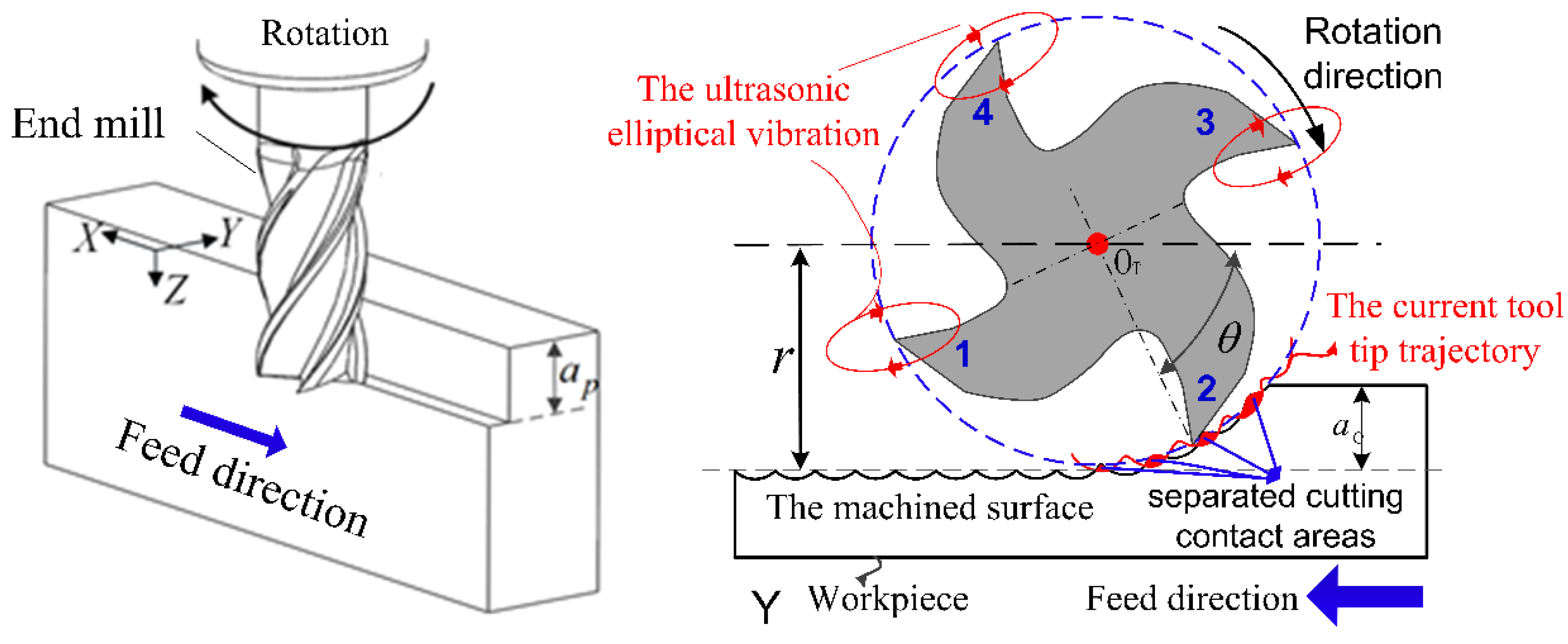

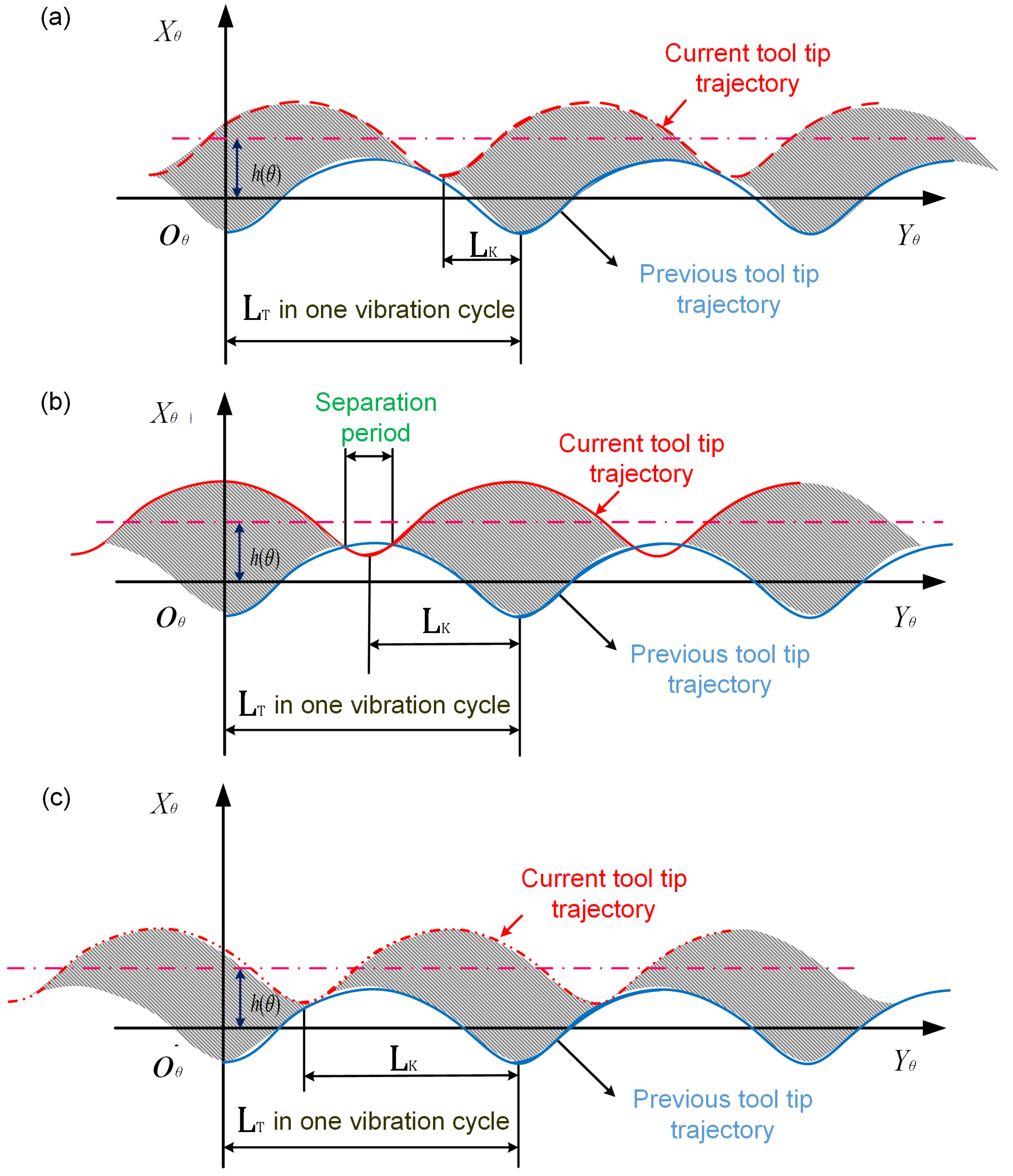


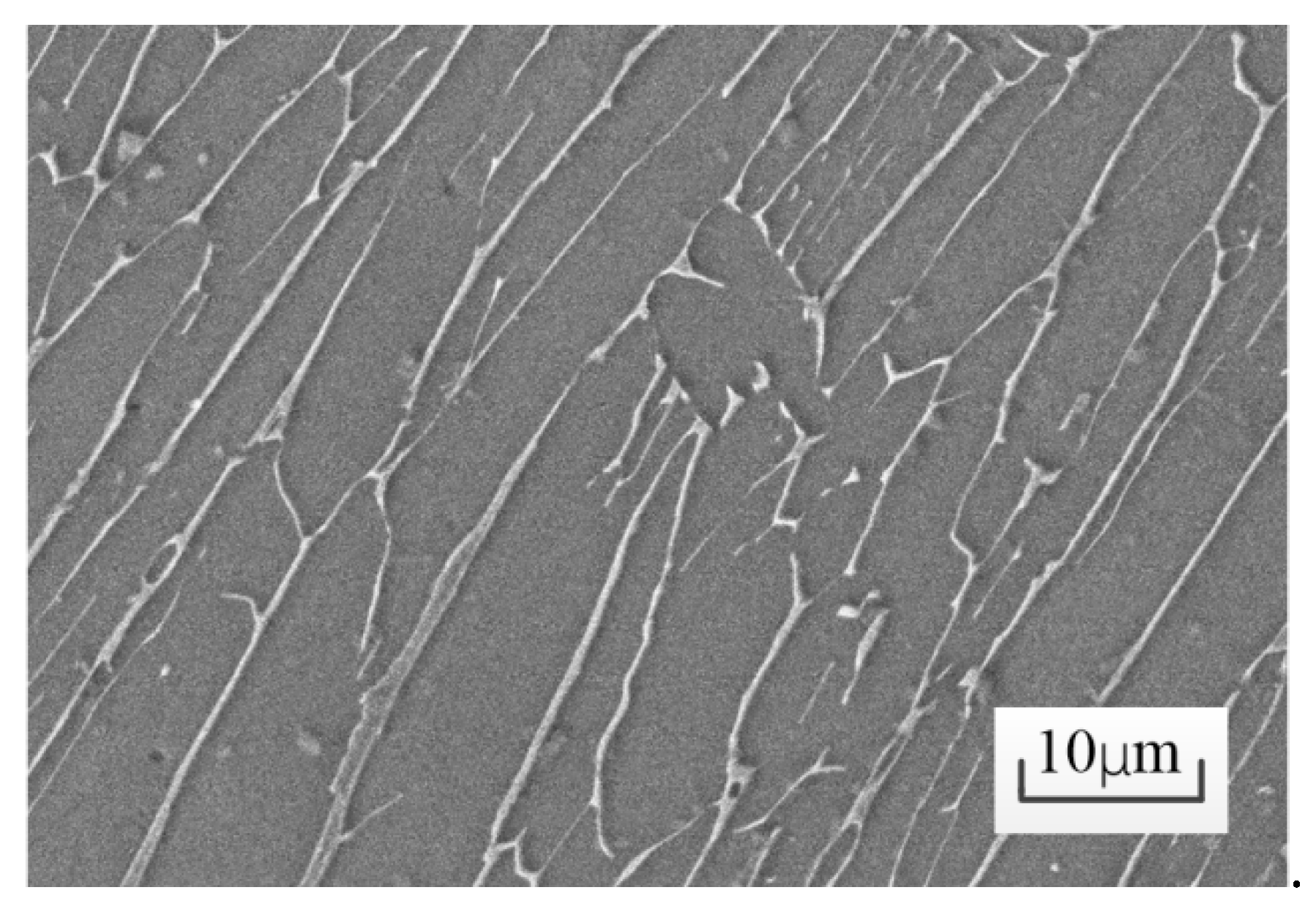
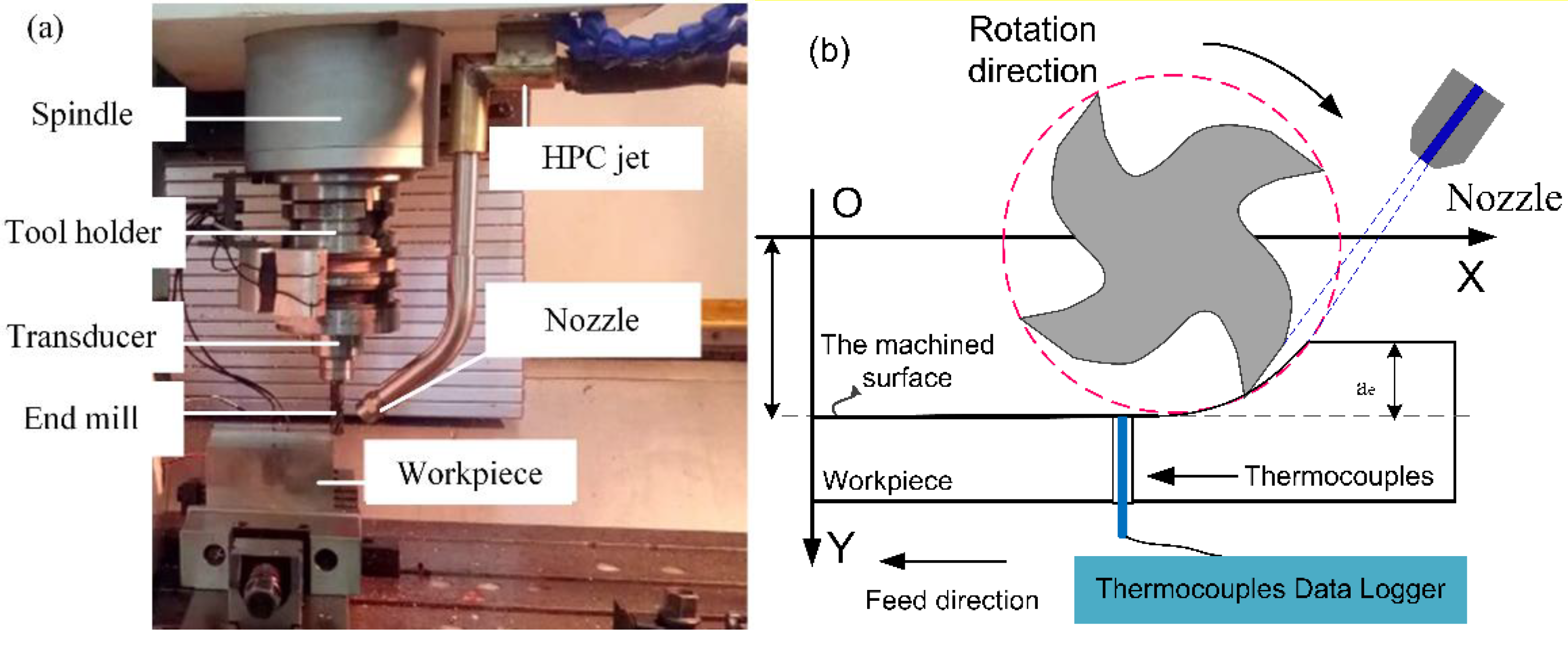

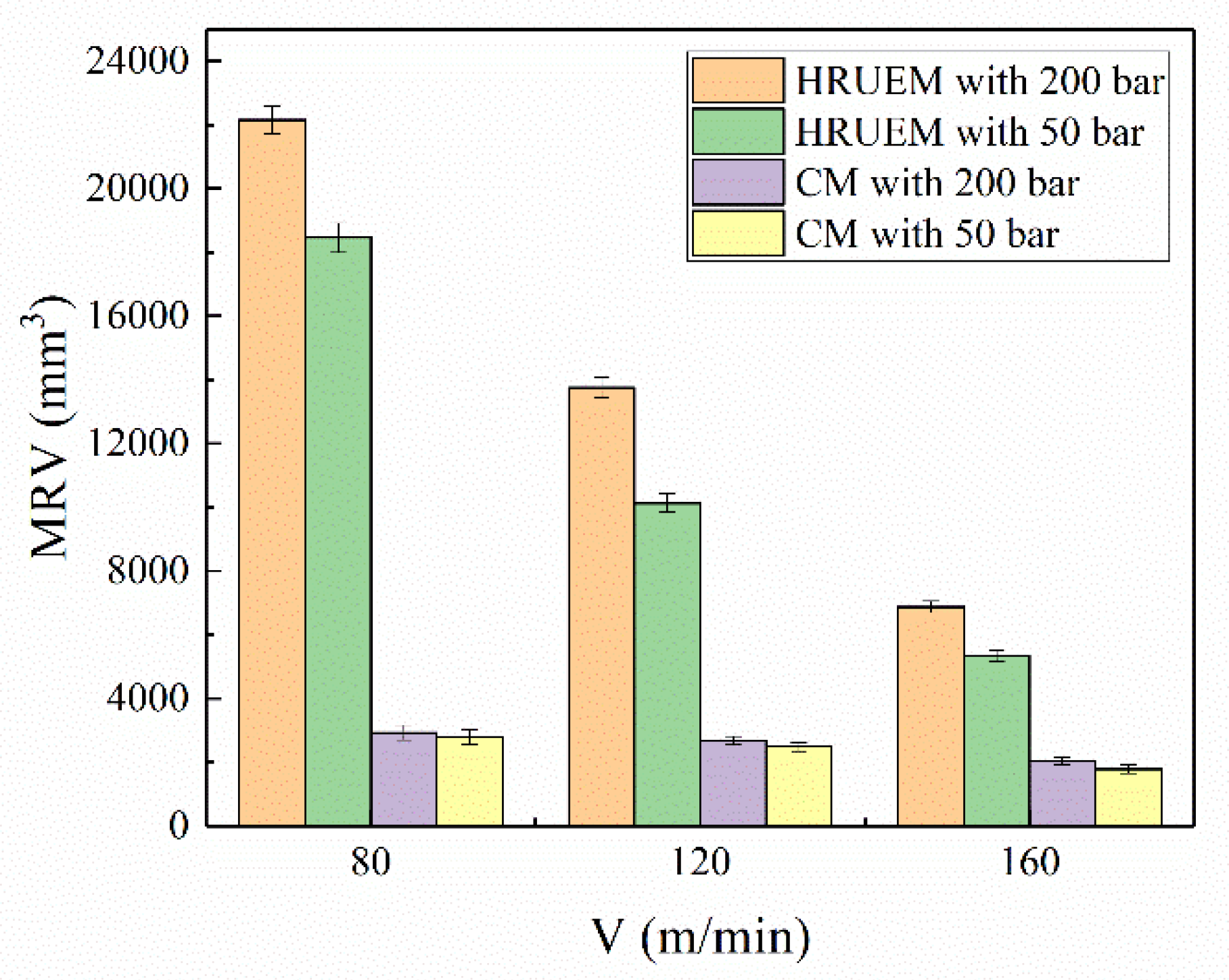
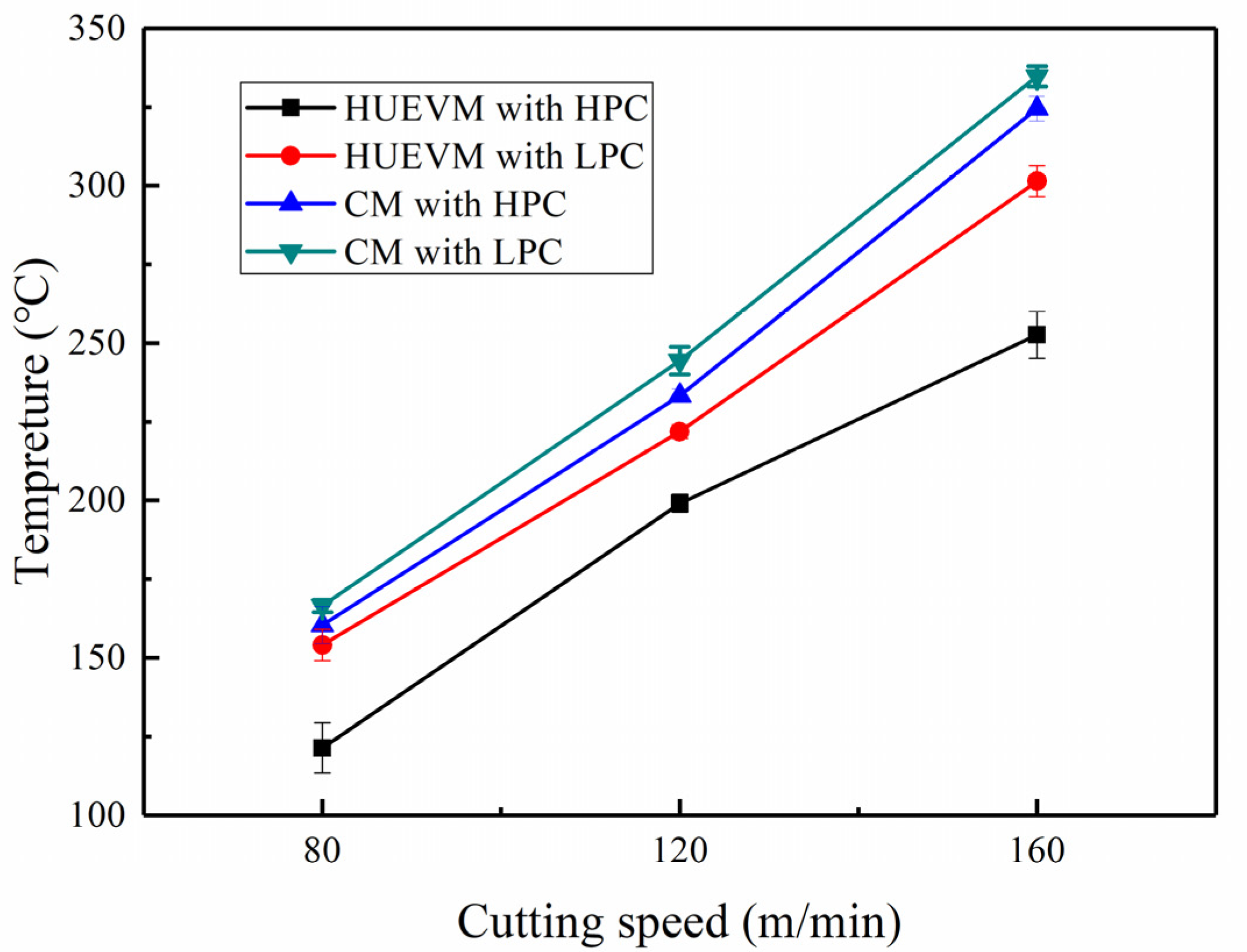
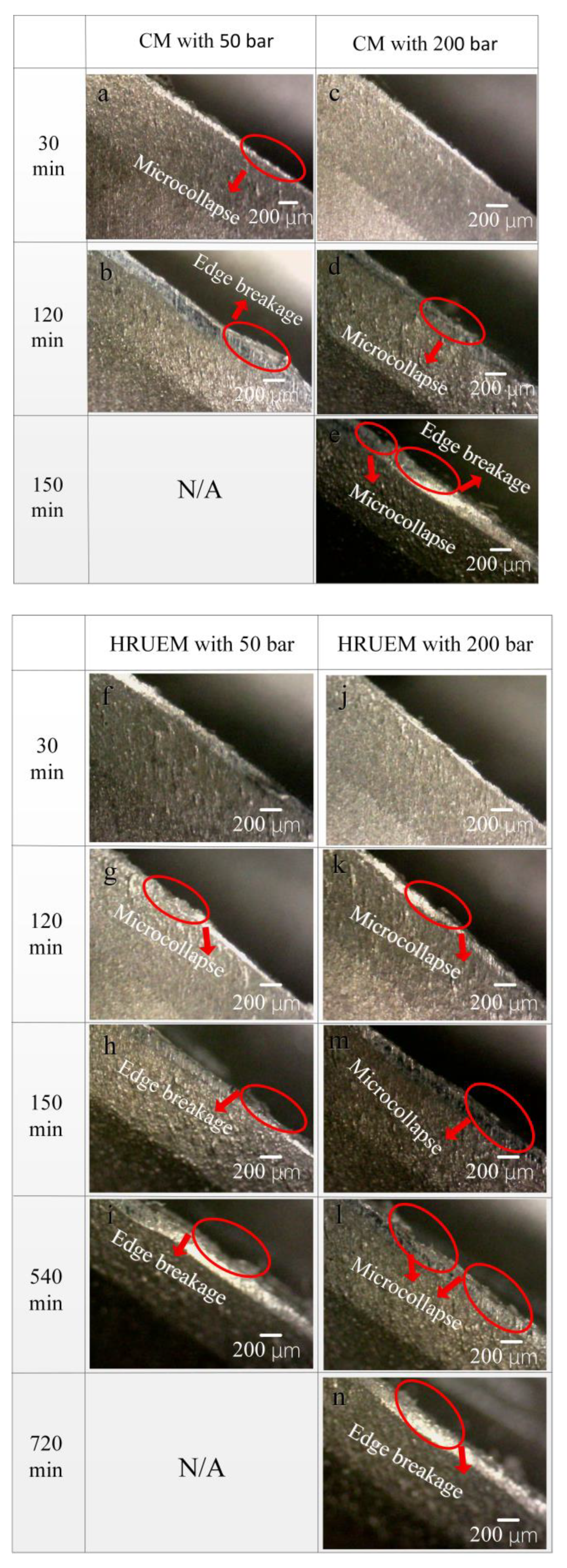
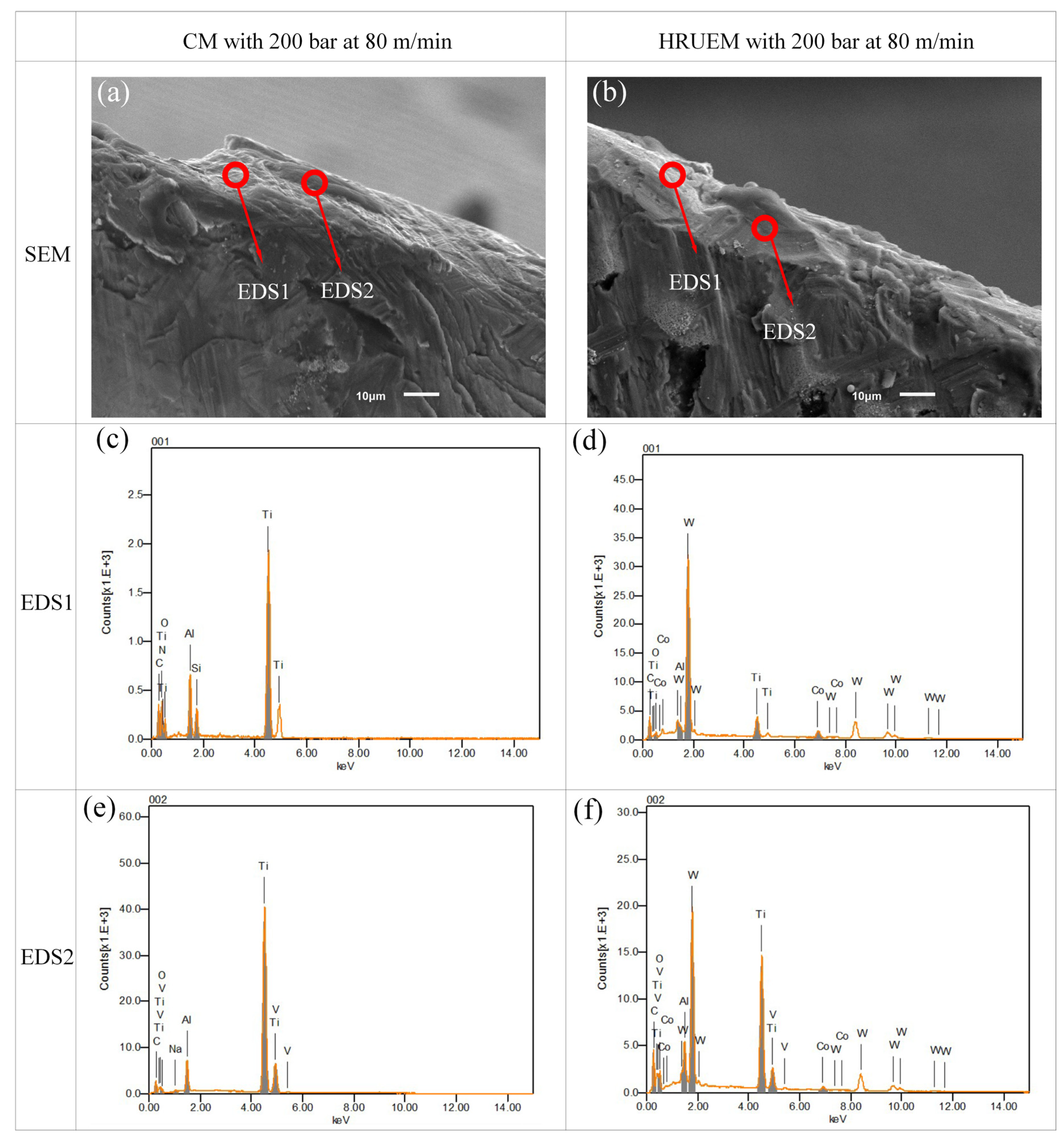
| Material | Density (kg/m3) | Hardness (HV) | Elastic Modulus (GPa) | Melting Temperature (°C) | Thermal Conductivity (W/mK) | Yield Strength (MPa) | |
|---|---|---|---|---|---|---|---|
| Ti-6Al-4V | 4429.0 | 320.0 | 114.0 | 1667.0 | 6.70 | 835.0 | |
| Base Material | Coating | Number of Cutting Edges | Diameter (mm) | Helix Angle (°) | Rake Angle (°) | Relief Angle (°) |
|---|---|---|---|---|---|---|
| Carbide | TiAlN | 4 | 12 | 38 | 10 | 8 |
| Milling Conditions | Axial cutting depth (mm) | 0.2 |
| Radial cutting depth (mm) | 5 | |
| Feed speed per tooth (mm/z) | 0.015 | |
| Nominal cutting speed (m/min) | 80, 120, 160 | |
| Type of milling | CM and HRUEM | |
| Vibration Conditions | Amplitudes A and B (m) | and |
| Frequency (Hz) | 17,880 | |
| Angle shift () | 90 | |
| Cooling Conditions | coolant pressure (bar) | 50, 200 |
© 2020 by the authors. Licensee MDPI, Basel, Switzerland. This article is an open access article distributed under the terms and conditions of the Creative Commons Attribution (CC BY) license (http://creativecommons.org/licenses/by/4.0/).
Share and Cite
Zhang, M.; Zhang, D.; Guo, H.; Gao, Z.; Geng, D.; Liu, J.; Jiang, X. High-Speed Rotary Ultrasonic Elliptical Milling of Ti-6Al-4V Using High-Pressure Coolant. Metals 2020, 10, 500. https://doi.org/10.3390/met10040500
Zhang M, Zhang D, Guo H, Gao Z, Geng D, Liu J, Jiang X. High-Speed Rotary Ultrasonic Elliptical Milling of Ti-6Al-4V Using High-Pressure Coolant. Metals. 2020; 10(4):500. https://doi.org/10.3390/met10040500
Chicago/Turabian StyleZhang, Mingliang, Deyuan Zhang, Hailin Guo, Ze Gao, Daxi Geng, Jiajia Liu, and Xinggang Jiang. 2020. "High-Speed Rotary Ultrasonic Elliptical Milling of Ti-6Al-4V Using High-Pressure Coolant" Metals 10, no. 4: 500. https://doi.org/10.3390/met10040500






